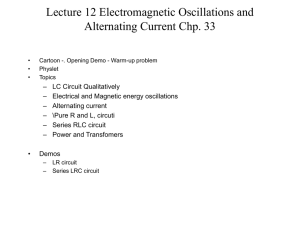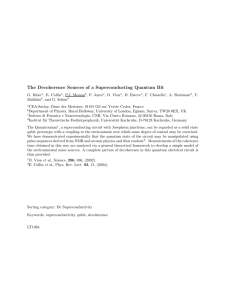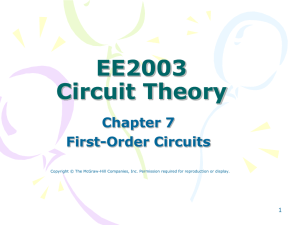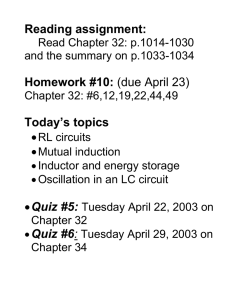First Order Circuits I
advertisement
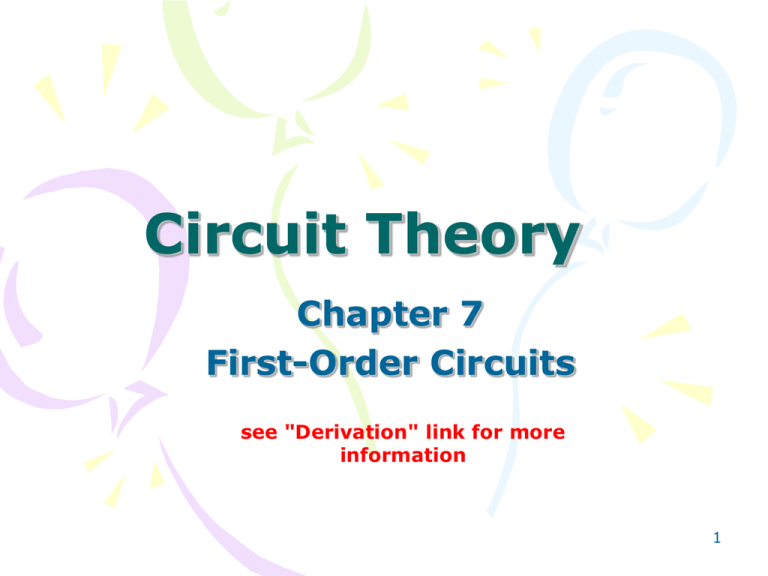
Circuit Theory Chapter 7 First-Order Circuits see "Derivation" link for more information 1 First-Order Circuits Chapter 7 7.1 7.2 7.3 7.4 7.5 The Source-Free RC Circuit The Source-Free RL Circuit Unit-step Function Step Response of an RC Circuit Step Response of an RL Circuit 2 7.1 The Source-Free RC Circuit (1) • A first-order circuit is characterized by a firstorder differential equation. By KCL iR iC 0 Ohms law v dv C 0 R dt Capacitor law • Apply Kirchhoff’s laws to purely resistive circuit results in algebraic equations. • Apply the laws to RC and RL circuits produces differential equations. 3 7.1 The Source-Free RC Circuit (2) • The natural response of a circuit refers to the behavior (in terms of voltages and currents) of the circuit itself, with no external sources of excitation. Time constant RC Decays more slowly Decays faster • The time constant of a circuit is the time required for the response to decay by a factor of 1/e or 36.8% of its initial value. • v decays faster for small and slower for large . 4 7.1 The Source-Free RC Circuit (3) The key to working with a source-free RC circuit is finding: v (t ) V0 e t / where RC 1. The initial voltage v(0) = V0 across the capacitor. 2. The time constant = RC. 5 7.1 Source-Free RC Circuit (4) Example 1 Refer to the circuit below, determine vC, vx, and io for t ≥ 0. Assume that vC(0) = 30 V. Answer: vC = 30e–0.25t V ; vx = 10e–0.25t ; io = –2.5e–0.25t A 6 7 7.1 Source-Free RC Circuit (5) Example 2 The switch in circuit below is opened at t = 0, find v(t) for t ≥ 0. Answer: V(t) = 8e–2t V 8 9 7.2 The Source-Free RL Circuit (1) • A first-order RL circuit consists of a inductor L (or its equivalent) and a resistor (or its equivalent) By KVL vL vR 0 di L iR 0 dt Inductors law Ohms law di R dt i L i (t ) I 0 e Rt / L 10 7.2 The Source-Free RL Circuit (2) A general form representing a RL i (t ) I 0 e where • • • t / L R The time constant of a circuit is the time required for the response to decay by a factor of 1/e or 36.8% of its initial value. i(t) decays faster for small and slower for large . The general form is very similar to a RC source-free circuit. 11 7.2 The Source-Free RL Circuit (3) Comparison between a RL and RC circuit A RL source-free circuit i (t ) I 0 e t / where L R A RC source-free circuit v(t ) V0 e t / where RC 12 7.2 The Source-Free RL Circuit (4) The key to working with a source-free circuit is finding: i (t ) I 0 e t / where RL L R 1. The initial voltage i(0) = I0 through the inductor. 2. The time constant = L/R. 13 7.2 The Source-Free RL Circuit (5) Example 3 Find i and vx in the circuit. Assume that i(0) = 5 A. Answer: i(t) = 5e–53t A 14 15 7.2 The Source-Free RL Circuit (6) Example 4 For the circuit, find i(t) for t > 0. Answer: i(t) = 2e–2t A 16 17 7.3 Unit-Step Function (1) • The unit step function u(t) is 0 for negative values of t and 1 for positive values of t. 0, u (t ) 1, t0 t0 0, u (t to ) 1, t to t to 0, u(t to ) 1, t to t to 18 7.3 Unit-Step Function (2) Represent an abrupt change for: 1. voltage source. 2. for current source: 19 7.4 The Step-Response of a RC Circuit (1) • The step response of a circuit is its behavior when the excitation is the step function, which may be a voltage or a current source. • Initial condition: v(0-) = v(0+) = V0 • Applying KCL, dv v Vs u (t ) c 0 dt R or v Vs dv u (t ) dt RC • Where u(t) is the unit-step function 20 7.4 The Step-Response of a RC Circuit (2) • Integrating both sides and considering the initial conditions, the solution of the equation is: t0 V0 v(t ) t / V ( V V ) e 0 s s Final value at t -> ∞ Complete Response = = Natural response (stored energy) V0e–t/τ Initial value at t = 0 + + t 0 Source-free Response Forced Response (independent source) Vs(1–e–t/τ) 21 7.4 The Step-Response of a RC Circuit (3) Three steps to find out the step response of an RC circuit: 1. The initial capacitor voltage v(0). 2. The final capacitor voltage v() or, the final DC voltage across C. 3. The time constant . v (t ) v () [v (0) v ()] e t / Note: The above method is a short-cut method. You may also determine the solution by setting up the circuit formula directly using KCL, KVL , ohms law, capacitor and inductor VI laws. 22 7.4 Step-Response of a RC Circuit (4) Example 5 Find v(t) for t > 0 in the circuit in below. Assume the switch has been open for a long time and is closed at t = 0. Calculate v(t) at t = 0.5. Answer: v(t ) 15e 2t 5 and v(0.5) = 0.5182V 23 24 7.5 The Step-response of a RL Circuit (1) • The step response of a circuit is its behavior when the excitation is the step function, which may be a voltage or a current source. • Initial current i(0-) = i(0+) = Io • Final inductor current i(∞) = Vs/R • Time constant = L/R t Vs Vs i (t ) ( I o )e u (t ) R R 25 7.5 The Step-Response of a RL Circuit (2) Three steps to find out the step response of an RL circuit: 1. The initial inductor current i(0) at t = 0+. 2. The final inductor current i(). 3. The time constant . i (t ) i () [i (0) i ()] e t / Note: The above method is a short-cut method. You may also determine the solution by setting up the circuit formula directly using KCL, KVL , ohms law, capacitor and inductor VI laws. 26 7.5 The Step-Response of a RL Circuit (4) Example 6 The switch in the circuit shown below has been closed for a long time. It opens at t = 0. Find i(t) for t > 0. Answer: i(t ) 2 e 10t 27 1) iL=20e-5t A io=-4e-5t A vo=-160e-5t V28 64% 2) 29 3) 30 vo=-60 + 90e-100t io=-2.25e-100t mA 4) 31 a) i=12 - 20e-10t A b) V(0+)=40 V


